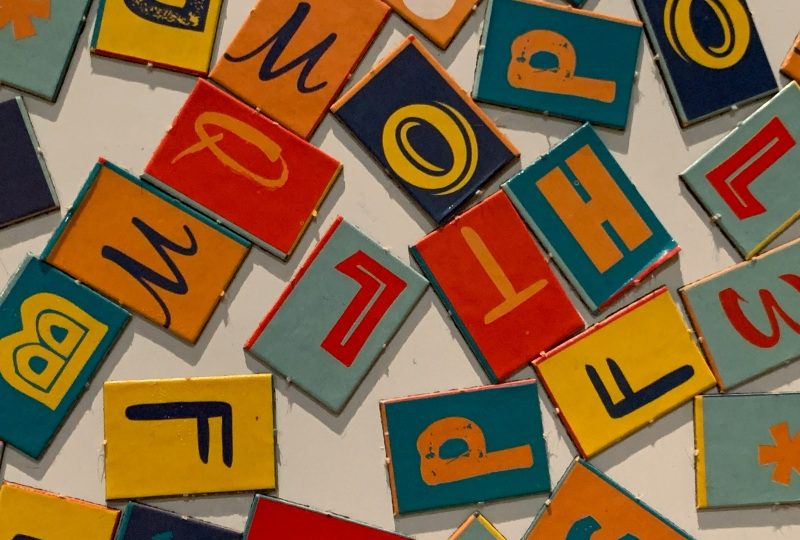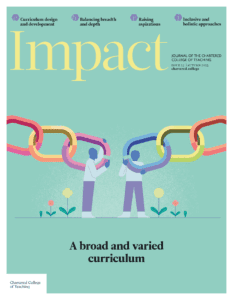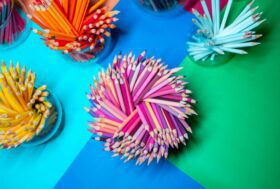Finding room for creativity and authenticity in the MFL classroom

JULIETTE CLARO, LECTURER IN EDUCATION, ST MARY’S UNIVERSITY, TWICKENHAM, UK
CHARLOTTE RYLAND, QUEEN’S COLLEGE, OXFORD; STEPHEN SPENDER TRUST, UK
The pipeline of linguists at higher education is drying up fast. Despite a slight increase in 2025 (Collen and Duff, 2025), languages entries at A-level and higher education remain low (British Academy, 2024). The announced closures of the languages programmes at Cardiff (Ayres-Bennett et al., 2025) and Aberdeen universities reflect a national crisis in developing future linguists. Arguably, there are many reasons why students choose not to carry on with languages after GCSE, from the perceptions that languages are too hard, elitist or lacking in careers opportunities, to losing students to STEM (science, technology, engineering and mathematics) subjects or to boredom (Bauckham, 2016). As languages teachers across the country continue to battle with their senior leadership teams to keep their A-level classes running, this article explores the place of creativity and authenticity in modern foreign languages and their role in supporting self-motivation and developing resilience, problem-solving skills, empathy and cultural capital within a squeezed curriculum.
To understand the challenges and opportunities linked with creative methodologies in the MFL curriculum, our special interest group joined the School of Education at St Mary’s University, Twickenham and Queen’s College, Oxford in a small-scale research project on supporting creativity in the MFL classroom.
Why are we talking about creativity in the MFL classroom?
In January 2025, the thought-provoking roundtable discussion at King’s University organised by Michael Slavinsky, Managing Director of Languages for All, made the case for languages post-16 and at higher education. The discussion shone a light on what ‘hooks’ young people into continuing with languages post-GCSE.
Year 12 pupils shared their reasons for choosing to carry on with their language(s) at A-level, giving an insight into what keeps languages ticking in schools:
- the feeling that they are good at it
- access to culture as a ‘hook’ (e.g. music, texts, television series, films, pen pals)
- access to out-of-classroom languages experiences that bring the curriculum to life (e.g. trips, speakers, careers talks, cultural events, university exchanges and projects)
In our visits to schools and MFL departments, we have witnessed opportunities for colleagues to be creative and spontaneous in the language classroom become scarcer.
In 2021, the OfstedThe Office for Standards in Education, Children’s Services and Skills – a non-ministerial department responsible for inspecting and regulating services that care for children and young people, and services providing education and skills research series on languages framed language learning around the three pillars of phonics, vocabulary and grammar. As these three pillars have become the holy grail of language learning, to support preparation for the new GCSE examinations in 2026, teachers diligently plan their curriculum around the 1,200 words on the syllabus, ensuring that phonics and grammar are assimilated along the way through grammar activities and translation exercises.
As the pipeline of future linguists dries up, we need to ask ourselves where the place of authenticity and creativity is in the MFL classroom, without losing sight of the knowledge-rich curriculum (Gibb, 2010) and the three pillars of language learning. With reduced teaching time on the timetable (Conti, 2016), how can they cohabit to support intrinsic motivation for language learning? In other words, how do we incorporate both knowledge and skills into our curriculum?
What is creativity and authenticity in the MFL classroom?
Defining authenticity and creativity within the context of the MFL classroom is essential to make sense of what we are exploring in this small-scale research project. Echoing Widdowson (2003), Gilmore (2007) borrows Morrow’s definition (1977) of authentic as:
a stretch of real language, produced by a real speaker or writer for a real audience and designed to convey a real message of some sort
Morrow, 1977, p. 14
The competences of creativity as a means with which to stimulate the executive functions of the brain are summarised by Collard (2016) for Education Scotland:
- constructive curiosity
- open–mindedness, flexibility and lateral thinking
- exploring the imagination by generating new ideas and content
- problem–solving.
And this is where creativity in MFL sits: creative approaches to authentic resources enable learners to connect their learning of phonics, vocabulary and grammar. These authentic resources can be used to stimulate spontaneous speaking or writing activities and to offer a vector for ‘liberation against insularity’ (DfEDepartment for Education - a ministerial department responsible for children’s services and education in England, 2013).
Barriers to creativity in languages
Our special interest group comprises over 60 MFL teachers and curriculum leaders with a varied level of experience from across England, France, Sweden, India and the UAE. Before focusing on solutions, we framed the problem by asking colleagues to reflect on the challenges to being creative and using authentic resources in their lessons. The reasons came in three strands:
- workload and lack of time or expertise for colleagues, especially non-specialists, to find and adapt authentic resources effectively for their classes
- the density of the curriculum content and the lack of time at Key Stages 3 and 4 to add authenticity and creativity in lessons
- rigidity in school systems and policies on prescribed methodologies limiting opportunities to be creative and reducing teachers’ autonomy.
Opportunities to inject more creativity and authenticity into the MFL classroom
The special interest group explored opportunities to inject creative ideas into lesson planning without having to completely reinvent their curriculum sequences. Colleagues shared their success stories as follows:
- developing resilience and self-motivation through cultural or authentic stimuli – colleagues shared examples of bringing popular culture into the lessons through music, poetry, films or visual artefacts, such as photos, cartoons or comic strips
- the importance of positive routines to set the tone for creativity (building prior knowledge to introduce authentic and creative content)
- incidental and positive use of the target language to build resilience through positive reinforcement and low-stakes incidental chat in the target language
- scaffoldingProgressively introducing students to new concepts to support their learning for accessibility (using glossaries or sentence-builders to develop problem-solving skills when using authentic resources)
- building confidence through phonics and performance in the target language in groups or pairs (e.g. role-plays, performances, singing, reciting poems)
- using songs, poems, videos and films to consolidate learning and bring authenticity
- using photos, images and short news articles as a stimulus for creativity, using the GCSE-style model to generate conversation on culture as starter activities
- using technologies to encourage creativity (video-making, blogs, AI-generated posters or brochures using the language creatively)
- developing exchanges with partner schools abroad or universities, where students have a chance to listen, read, speak and write with authenticity (e.g. pen pal letters, trips, exchanges)
- developing curriculum sequences and central planning resources that embed creativity instead of it being added on or being tokenistic.
Early findings of the student voice survey conducted highlight the top five activities that support language learning at Key Stages 3 and 4 as follows:
- games where students use the language creatively
- the use of songs
- using technologies to consolidate learning
- chorus repetitions
- films and television series in the target language.
This research is in its early stage and has limitations. It is likely that the teachers who joined the special interest group already felt positive about the impact of creative approaches in MFL on motivation, engagement and outcomes. One notable emerging trend is that colleagues in multi-academy trusts, where the curriculum and resources are centralised, found creativity important but were not able to articulate it as much in practice as colleagues in standalone academies, who seemed to have more autonomy in the content and methods of delivery of their intended curriculum. This is an area that requires further research and is beyond the scope of our special interest group.
What came back from our discussions was that teachers have as much fun teaching creative lessons as students do in the lessons. Low-level disruption is reduced through engagement and motivation, and students have a sense of satisfaction when they adapt their prior knowledge in context with an authentic resource and can be creative with it.
Next steps for creativity in the MFL classroom research project
In response to the barriers expressed by colleagues, a platform of resources was created for colleagues lacking time, expertise or ideas on how to make authentic resources accessible to all learners. Following our presentation at the Pedagogy in Action conference at St Mary’s University in April 2025, the group received support from the Association for Language Learning (ALL), who gave us an opportunity to incorporate our research within the scope of their partnerships. Further research will follow on creativity at Key Stages 4 and 5, building cultural capital in languages to ‘hook’ learners into studying language beyond GCSE and A-level. The transition between the new GCSE and A-level will require some careful planning to allow students exposure to authentic resources, texts and media, to prepare them for the depth of analysis and language post-16.
Resources kindly shared by colleagues who gave consent to share their work through our Padlet can be found at:
https://padlet.com/julietteclaro/creative-resources-in-the-mfl-classroom-sig-znepb5cv1o3e1vcl
The ALL special interest group can be found at: www.all-languages.org.uk/creativity-sig
References
- Ayres-Bennett W, Burdett C and Cayley E (2025) Cardiff’s closure of modern languages will tongue-tie its humanities. Times Higher Education. Available at: www.timeshighereducation.com/opinion/cardiffs-closure-modern-languages-will-tongue-tie-its-humanities (accessed 23 July 2025).
- Bauckham I (2016) Modern foreign languages pedagogy review. Teaching Schools Council. Available at: https://ncelp.org/wp-content/uploads/2020/02/MFL_Pedagogy_Review_Report_TSC_PUBLISHED_VERSION_Nov_2016_1_.pdf (accessed 23 July 2025).
- British Academy (2024) Students choosing less diverse range of subjects post-16 than they did two decades ago, new research finds. Available at: www.thebritishacademy.ac.uk/news/report-shows-students-choosing-less-diverse-range-of-subjects-post-16 (accessed 23 July 2025).
- Collard P (2016) Creativity and learning: What is the connection? Education Scotland. Available at: cre36-creativity-thought-piece-paul-collard-june-2016.pdf (accessed 1 December 2024).
- Collen I and Duff J (2025) Language Trends England 2025. British Council. Available at: www.britishcouncil.org/research-insight/language-trends-england-2025 (accessed 23 July 2025).
- Conti G (2016) The ugly truth about school-based modern language teaching. In: The Language Gym. Available at: https://gianfrancoconti.com/2016/11/26/the-ugly-truth-about-school-based-modern-language-teaching (accessed 23 July 2025).
- Department for Education (DfE) (2013) National curriculum in England: Languages programme of study. Available at: www.gov.uk/government/publications/national-curriculum-in-england-languages-progammes-of-study/national-curriculum-in-england-languages-progammes-of-study#key-stage-3-modern-foreign-language (accessed 23 July 2025).
- Gibb N (2010) The importance of a knowledge-rich curriculum. Department for Education. Available at: www.gov.uk/government/speeches/the-importance-of-a-knowledge-rich-curriculum (accessed 23 July 2025).
- Gilmore A (2007) Authentic materials and authenticity in foreign language learning. Language Teaching 40(2): 97–118.
- Morrow K (1977) Authentic texts and ESP. In: Holden S (ed) English for Specific Purposes. London: Modern English Publications, pp. 13–17.
- Ofsted (2021) Research review series: Languages. Available at: www.gov.uk/government/publications/curriculum-research-review-series-languages (accessed 23 July 2025).
- Widdowson HG (2003) Defining Issues in English Language Teaching. Oxford: Oxford University Press.










